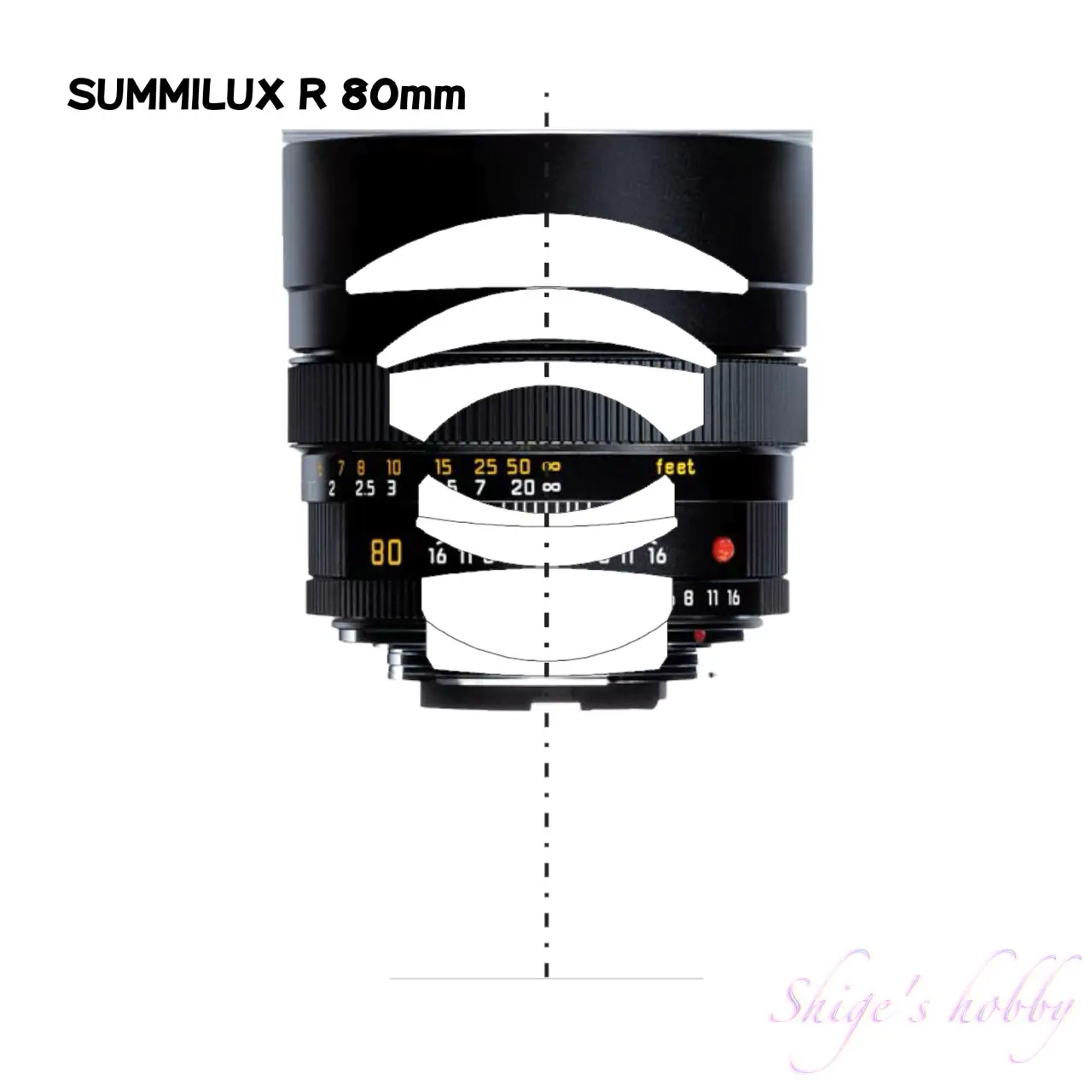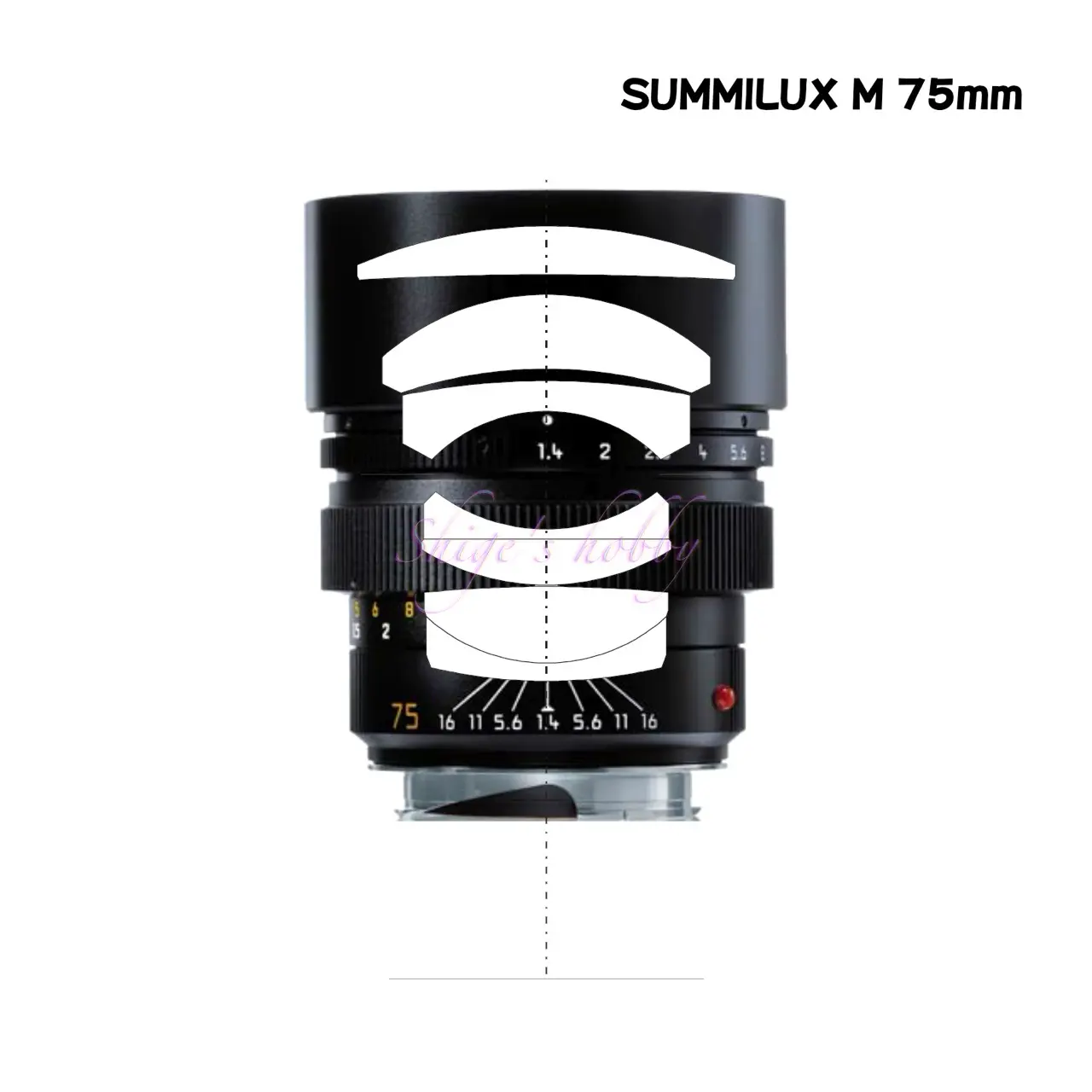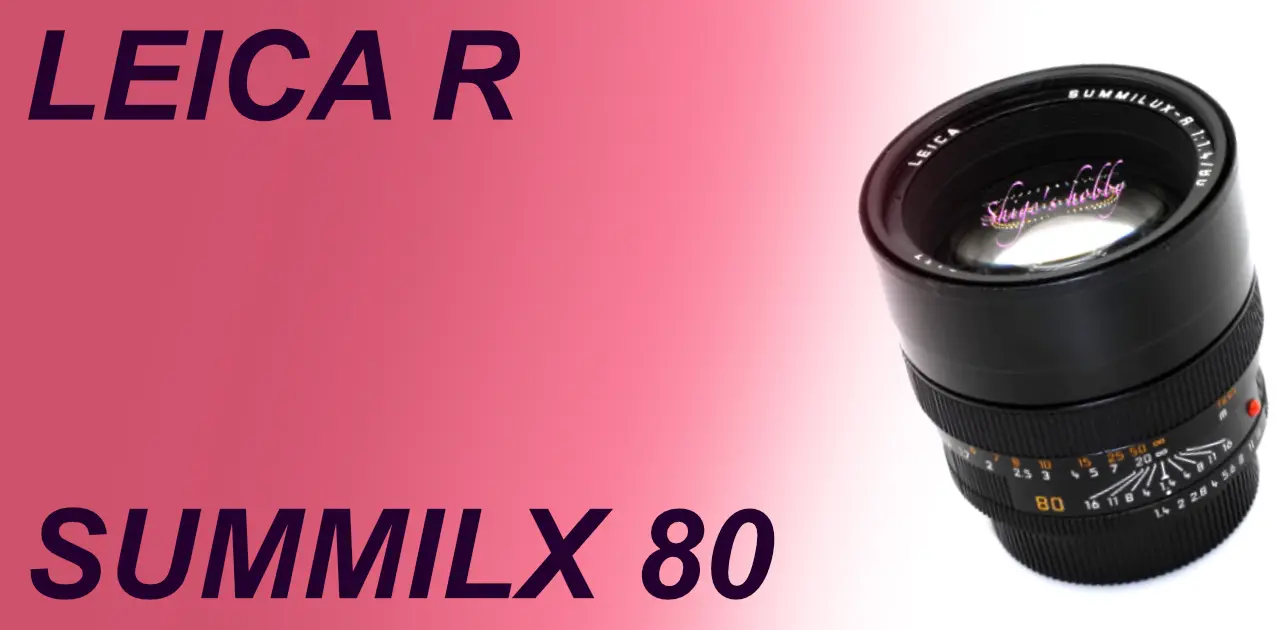A review and sample photos of the SUMMILUX R 80mm F1.4 used with a film camera, a digital SLR camera and a digital mirrorless camera.
- Please see the disclaimer regarding advertising here.
- Italicized links in the text are advertisement links that take you to other sites.
Table of contents
Gallery
The following body was used to take the example photos.
- LEICA R8 +FUJIFILM100 +NIKON LS-50(COOLSCAN-V)(Film SLR camera)
- LEICA R8 +Digital Module R(DMR)(Digital SLR camera)
- LEICA SL typ601(mirrorless digital camera)
- LEICA CL(mirrorless digital camera)
- EOS 1Ds Mk-III(Digital SLR camera)
- EOS 1D Mk-IV(Digital SLR camera)
- SONY α7Sii(mirrorless digital camera)
- FUJIFILM X-Pro1 +Metabones Speed booster(mirrorless digital camera)
- HASSELBLAD X2D-100C(mirrorless digital camera)
Review
1.Overview
The Leica Summilux-R 80mm is a large-aperture medium telephoto lens for the Leica R mount, and approximately 12,000 lenses were manufactured over the 29 years from 1980 to 2009.
The main specifications are as follows, and details are listed in the table.
- Aperture value: 1.4
- Lens construction: 7 elements in 5 groups
- Aperture blades: 10
- Minimum focusing distance: 0.8m
- Hood: Built-in
The basic elements, such as the lens construction and the lens barrel with built-in lens hood, have remained the same since the initial release, and the mount is available in 3-cam, R-cam, and ROM terminal versions, and can be used with SLR Leica R bodies from the R3 onwards.
2.Usability
The LEICA SUMMILUX R 80mm has a thick lens barrel, and like the Summilux 35mm, it pairs well with large film SLR cameras like the LEICA R8 and R9, and the Canon EOS-1 series. For digital cameras, it also pairs well with the LEICA SL series, LUMIX S1 series, and Canon EOS-1D series.
As a prime lens, the lens barrel only features an aperture and focus ring. The focus ring rotates 180 degrees from infinity to the minimum focusing distance of 0.8m. The aperture ring can be adjusted from 1.4 to 16 in 1/2-step increments.
The lens I own is in very good condition with a ROM connector, with only minor scratches on the focus ring.
The bokeh at full aperture is typical of a large-aperture, medium telephoto lens, and the blur that melts away from the focal plane may be a bit repetitive, but it’s one that you’ll want to use frequently.
There should be a large number of this lens in circulation in Japan, and it was often seen on the second-hand market in the 2000s. However, as is the general trend with R-mount lenses, it has become less common recently, becoming a bit rarer, and its price has risen compared to before.
Mount Adapter
■ Film camera LEICA R8
Shooting with the LEICA SUMMILUX R 80mm on the LEICA R8 film camera results in a dull color appearance due to the negative film used not being color-adjusted after scanning with the FUJIFILM 100, but the three-dimensionality of the figures is clearly visible.
When shooting at maximum aperture, changing the LEICA R8’s focusing screen to a 14343 Universal Split Wedge Micro Prism with a split + micro prism in the center makes it easier to see the focus peak in the center. The downside of this screen is that focus adjustment is limited to the center of the viewfinder. At the maximum aperture of f/1.4, if you move the camera to recompose after determining the focus position, the focus will be slightly blurred.
It is also possible to focus using a 14387/14395 (DMR) Ground-Glass Screen with Grid, which is convenient for composing.
■ Digital SLR camera LEICA R8 +DMR
When taking images with the LEICA SUMMILUX R 80mm using the Digital Module R, because the camera’s image sensor is smaller than 35mm film, the image is cropped to an area 1.37 times the displayed focal length. An 80mm focal length is equivalent to a 110mm focal length in 35mm format.
By cutting out the peripheral areas, where roughness is more visible with a digital camera, you can obtain images with higher resolution. The texture of the cat’s fur is also well captured.
When I acquired the DMR, the following focusing screens used with film cameras were no longer available, so I used the standard screen. Shooting at full aperture with the standard screen resulted in photos with questionable focus, so when quick shooting wasn’t necessary, I used focus bracketing, taking around three shots at slightly shifted focus positions.
- 14392 (DMR) Universal Split Wedge Micro Prism – Center split + micro prism
- 14395 (DMR) Ground-Glass Screen with Grid – Ground glass
The DMR-specific focusing screen features a rectangular frame inside the screen to indicate the shooting range, as it is designed for sensors smaller than 35mm film.
■Digital SLR camera CANON EOS 1Ds MK-III
Looking at the results from the Canon EOS 1Ds MK-III, the camera uses a 20-megapixel 35mm full-frame sensor, and provides clear resolution even at the periphery as long as the subject is on the same plane as the focus point, resulting in a well-defined image across the entire frame.
Even in scenes where false colors are common, they are barely noticeable, demonstrating performance that is more than practical for the 2020s.
There were no issues using the EOS 1DS MK-III, and because the distance between the lens and film plane near the mount is sufficient, I never encountered Error 20 (Err20), which occurs when the lens and camera interfere with each other. Because it’s a bright f/1.4 lens, switching to the EOS Super Precision Matte Ec-S focusing screen also improves focusing accuracy.
■Digital SLR camera CANON EOS 1D MK-IV
The Canon EOS 1D MK-IV has an APS-H sensor, which is smaller than 35mm film, and the 35mm conversion coefficient is 1.3x. This means that the 80mm focal length of this lens is equivalent to a 104mm focal length in 35mm, which is slightly on the telephoto side.
Because the sensor is smaller, the edges are cut off (cropped), so the image feels more uniform and neat than with the 1Ds Mark-III. As mentioned above, the resulting image is narrower than with 80mm, so you tend to place the subject in the center, so be careful to select and select the subject in the viewfinder to avoid monotony.
The sensor size of the 1D series is close to that of the LEICA Digital Module R, so I use it as a DMR alternative.
■Mirrorless digital cameras LEICA SL typ601 & LEICA CL
The LEICA SL typ601 has a 24-megapixel 35mm full-frame sensor, which is about 20% more pixels than the Canon EOS 1Ds MK-III. The 20% increase in pixels is barely noticeable.
The LEICA CL has an APS-C sensor, which is smaller than 35mm film, and is converted to 35mm film with a factor of 1.5. This means that this lens, with its 80mm focal length, is equivalent to a 120mm focal length in 35mm film, making it closer to the telephoto side.
Both cameras are equipped with 24-megapixel sensors, and although the sensor sizes are different, both offer fully usable resolution and sharp edges.
When using the digital mirrorless Leica SL typ601 with the Leica R-Adapter L (16076), focal length, aperture, and other information are recorded in EXIF. This is extremely useful for lazy people who don’t like to take notes.
With a DMR (LEICA Digital Module R), only the focal length is recorded in EXIF.
With a mirrorless camera that can use an EVF, the focus point magnification function eliminates the concerns about focus point that can be a bit of a worry with SLR cameras.
■Mirrorless digital camera SONY α7Sii
The SONY α7Sii has a 12-megapixel 35mm full-frame sensor, which is roughly the same pixel count as the LEICA Digital Module R among the cameras used here. The lens has ample capacity for a 10-megapixel sensor, so it can be used with confidence. Also, like other mirrorless cameras, the magnified display in the electronic viewfinder makes focusing at wide open apertures a breeze.
■Mirrorless digital camera FUJIFILM X-Pro1 +Metabones Speed booster
This is a photo taken using the METABONES SPEED BOOSTER x0.71 focal reducer. When attached to a camera with a sensor smaller than 35mm, the focal reducer shortens the focal length, which is increased by the sensor’s coefficient, by magnifying it with the mount adapter’s auxiliary lens. In the case of the FUJIFILM X-Pro1, an 80mm focal length lens would be 1.5 times larger (120mm) due to the sensor size, but by multiplying it by 0.71 with the focal reducer, it becomes equivalent to an 85mm focal length. This magnification lens tends to cause distortion in the peripheral images, but in dark environments like this example, this distortion is not noticeable. The center of the image retains the good qualities of the original lens.
■Mirrorless medium-format digital sensor camera HASSELBLAD X2D-100C
It was used on a HASSELBLAD X2D-100C medium-format digital mirrorless camera via a NOVOFLEX HAX/LER (Leica R lenses to Hasselblad x 1D Camera) mount adapter.
The Summilux 80mm has a wide image circle, nearly covering the HASSELBLAD/FUJIFILM digital medium-format sensor size (44mm x 33mm).
As can be seen in the sample images, there is some light falloff at the edges of the sky, and some distortion at the edges of landscapes. However, these are tolerable depending on the shooting situation. By applying a 0.8x 35mm conversion factor for the medium-format digital sensor, the lens can be used as a lens with a focal length equivalent to 64mm. We believe the same results can be achieved with Fujifilm GFX series lenses, which have a similar sensor size.
These results also indicate that the lens has an image circle larger than that of the 35mm format, meaning that sufficient image quality can be expected even at the edges of the image when using a camera with a 35mm full-frame sensor.
3.Summary
To sum up, the SUMMILUX R 80mm F1.4 is a large-aperture lens that represents the Leica R mount, along with the SUMMILUX R 35mm F1.4. A long time ago, it was always available on the second-hand market, but in the 2020s, it has become less common.
With a single-lens reflex camera, it was sometimes difficult to adjust the focus position, but with the electronic viewfinder of a mirrorless camera, this worry is eliminated, making it easier to use.
Not only is it high-resolution, but the depiction that also has a subtle softness is addictive.
Specifications, considerations, etc.
SUMMILUX R 80 and SUMMILUX M 75
Leica released the Summilux-M 75mm with almost the same lens configuration at the same time as the Summilux-R 80mm. Since M-type lenses are made to fit the viewfinder frame of the camera, it is natural that a focal length of 75mm was chosen as a medium telephoto lens.
Considering the reason why the focal length of this lens was 80mm, Leica’s lineup of SLR lenses after the standard lens is 50, 60, and 90, and either 70 or 80 could be candidates because the numbers are arranged better when the last digit is 0 than 75mm. Also, in the 1980s, 85mm was the mainstream interchangeable lens for portrait lenses of other companies’ SLR cameras, so if you were to create a large-aperture lens for portraits, it would be natural to choose 80mm rather than 70mm.
If the focal length is extended to 90mm, skipping 70 and 80, it would be difficult to share the design with the 75mm lens. The approximate size of the Summilux 90mm F1.4 is 64.3mm, and if the barrel width is increased by 10mm (5mm thickness on one side x 2) to ensure the rigidity of the barrel and to include mechanical parts, the lens diameter will be 74mm.
Leica has released two large-diameter lenses, the NOCTILUX M 75mm F1.25 in 2018 and the SUMMILUX M 90mm F1.5 in 2021, and both lenses have a maximum lens diameter of 74mm. Based on this, if a 90mm F1.4 for SLR cameras was made, a thick lens with a maximum lens diameter of 74mm would have been created.
In addition, the SUMMILUX M 90mm F1.5 will cost over 2 million yen in 2025, so releasing it as an R-mount lens in the 1980s would have been difficult in terms of cost and manufacturing technology.
Only Leica lenses can allow you to create so many different fantasies with just one lens.
- The lens construction diagrams are quoted from each company’s materials, and the sizes have been adjusted by us, so they are not exact.


| Item | SUMMILUX R | SUMMILUX M |
| focal length(mm) | 80 | 75 |
| Maximum aperture | 1.4 | 1.4 |
| Minimum aperture | 16 | 16 |
| Lens configuration | 9 | 10 |
| Leaf blade | 7 elements in 5 groups | 7 elements in 5 groups |
| Minimum distance(m) | 0.8 | 0.75 |
| Lens length(mm) | 69 (from R mount surface) R mount flange back 45.5 Total: 114.5 | 80 (from M mount surface) M mount flange back 27.8 Total: 107.8 |
| Lens max diameter(mm) | 75 | 69 |
| Filter type | 67 | 60 |
| Weight(g) | 700 | 560 |
| Hood | Build in | Early model: Hook fastening Late model: Built-in |
| Lens mount | LEICA R | LEICA M |
| Release date | 1980 | 1980 |
| Production numbers | 12,250 | 14,752 |
Reference links
Affiliate link

Amazon Prime Sale
Update history
- 2025.10.5
- 2025.4.5
- 2024.8.17
- 2024.2.11:Update
- 2022.04.07:First draft



Be First to Comment